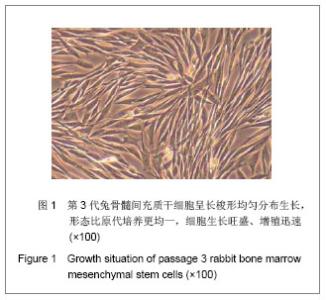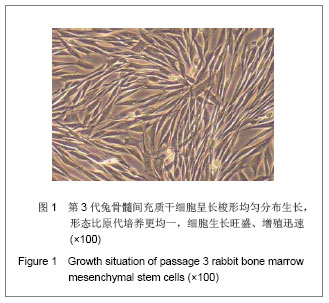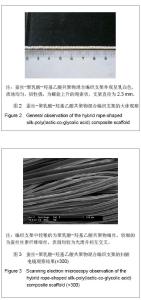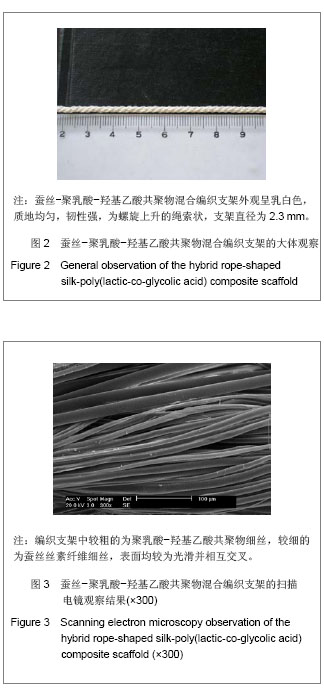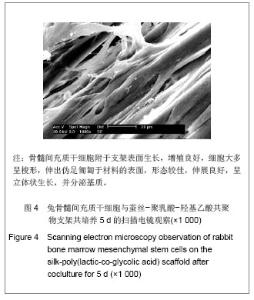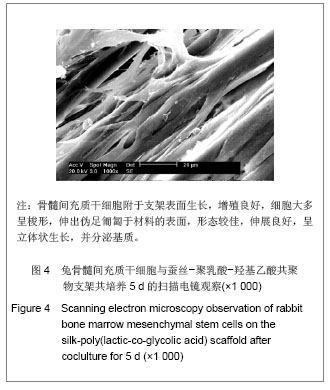| [1]James AC,Helen HL,Frank KK,et al.Fiber-based tissue-engineered scaffold for ligament replacement:design considerations and in vitro evaluation. Biomaterials.2005; 26(13):1523-1532. [2]Chen K,Sahoo S,He P,et al.A hybrid silk/RADA-based fibrous scaffold with triple hierarchy for ligament regeneration.Tissue Eng Part A.2012;18(13-14):1399-1409.[3]Mandal BB,Grinberg A,Gil ES,et al.High-strength silk protein scaffolds for bone repair.Proc Natl Acad Sci USA.2012; 109 (20):7699-7704.[4]Zhang WY,Yang YD,Fang GJ,et al.Zhongguo Weisheng Jianyan Zazhi.2011;21(12):2868-2870.张文元,杨亚冬,房国坚,等. 蚕丝-PLGA混合编织支架材料的细胞毒性检测[J].中国卫生检验杂志,2011,21(12):2868-2870.[5]Zhang WY,Yang YD,Fang GJ,et al. Zhongguo Weisheng Jianyan Zazhi.2012;22(2):237-239.张文元,杨亚冬,房国坚,等. 蚕丝-PLGA编织支架的生物安全性评价方法研究和应用[J].中国卫生检验杂志,2012,22(2):237- 239.[6]Zhang WY,Yang YD,Fang GJ,et al. Zhongguo Zuzhi Gongcheng Yanjiu yu Linchuang Kangfu.2006;10(13):44-46.张文元,杨亚冬,房国坚,等.不同冻存时间与温度对兔骨髓基质干细胞存活率的影响[J].中国组织工程研究与临床康复,2006, 10(13):44-46.[7]Zhang Y,Wu C,Luo T,et al.Synthesis and inflammatory response of a novel silk fibroin scaffold containing BMP7 adenovirus for bone regeneration.Bone.2012;51(4):704-713.[8]Li F,Chen YZ,Miao ZN,et al.Human placenta-derived mesenchymal stem cells with silk fibroin biomaterial in the repair of articular cartilage defects.Cell Reprogram. 2012; 14(4):334-341.[9]Chen X,Qi YY,Wang LL,et al.Ligament regeneration using a knitted silk scaffold combined with collagen matrix. Biomaterials.2008;29(27):3683-3692.[10]Fan H,Liu H,Wang EJ,et al.In vivo study of anterior cruciate ligament regeneration using mesenchymal stem cells and silk scaffold. Biomaterials.2008;29(23):3324-3337.[11]Chen JL,Yin Z,Shen WL,et al.Efficacy of hESC-MSCs in knitted silk-collagen scaffold for tendon tissue engineering and their roles. Biomaterials.2010;31(36):9438-9451.[12]Wang G,Hu X,Lin W,et al.Electrospun PLGA-silk fibroin-collagen nanofibrous scaffolds for nerve tissue engineering.In Vitro Cell Dev Biol Anim.2011;47(3):234-240.[13]Laurencin CT,Freeman JW.Ligament tissue engineering:an evolutionary materials science approach.Biomaterials.2005;26(36):7530-7536.[14]Cao Y,Wang B.Biodegradation of silk biomaterials.Int J Mol Sci.2009;10(4):1514-1524.[15]Kim UJ,Park J,Kim HJ,et al.Three dimensional aqueous-derived biomaterial scaffolds from silk fibroin. Biomaterials.2005;26(15):2775-2785.[16]Altman GH,Horan RL,Lu HH,et al.Silk matrix for tissue engineered anterior cruciate ligaments.Biomaterials.2002;23(20):4131-4141.[17]Mandal BB,Kundu SC.Biospinning by silkworms:Silk fiber matrices for tissue engineering applications.Acta Biomater. 2010;6(2):360-371.[18]Liu H,Fan H,Wang Y,et al.The interaction between a combined knitted silk scaffold and microporous silk sponge with human mesenchymal stem cells for ligament tissue engineering.Biomaterials.2008;29(6):662-674.[19]He P,Ng KS,Toh SL,et al. In vitro ligament-bone interface regeneration using a trilineage coculture system on a hybrid silk scaffold.Biomacromolecules.2012;13(9):2692-2703.[20]Fan H,Liu H,Toh SL,et al.Anterior cruciate ligament regeneration using mesenchymal stem cells and silk scaffold in large animal model. Biomaterials.2009;30(28):4967-4977.[21]Liu H,Fan H,Toh SL,et al.A comparison of rabbit mesenchymal stem cells and anterior cruciate ligament fibroblasts responses on combined silk scaffolds. Biomaterials.2008;29(10):1443-1453.[22]Li M,Ogiso M,Minoura N.Enzymatic degradation behavior of porous silk fibroin sheets.Biomaterials.2003;24(2):357-365.[23]Wang Y,Kim HJ,Karageorgiou V,et al.Stem cell-based tissue engineering with silk biomaterials. Biomaterials.2006;27(36): 6064-6082.[24]Park BH,Zhou L,Jang KY,et al.Enhancement of tibial regeneration in a rat model by adipose-derived stromal cells in a PLGA scaffold.Bone.2012;51(3):313-323.[25]van Eijk F,Saris DB,Creemers LB,et al.The effect of timing of mechanical stimulation on proliferation and differentiation of goat bone marrow stem cells cultured on braided PLGA scaffolds. Tissue Eng Part A.2008;14(8):1425-1433.[26]Urita Y,Komuro H,Chen G,et al.Evaluation of diaphragmatic hernia repair using PLGA mesh-collagen sponge hybrid scaffold:An experimental study in a rat model.Pediatr Surg Int.2008;24(9):1041-1045.[27]Wang X,Sui S.Pulsatile culture of a poly(DL-lactic-co-glycolic acid) sandwiched cell/hydrogel construct fabricated using a step-by-step mold/extraction method.Artif Organs.2011; 35(6):645-655.[28]van Eijk F,Saris DB,Fedorovich NE,et al.In vivo matrix production by bone marrow stromal cells seeded on PLGA scaffolds for ligament tissue engineering.Tissue Eng Part A.2009;15(10):3109-3117.[29]Vaquette C,Slimani S,Kahn CJ,et al.A poly(lactic-co-glycolic acid) knitted scaffold for tendon tissue engineering:an in vitro and in vivo study.J Biomater Sci Polym Ed.2010;21(13): 1737-1760.[30]Sahoo S,Ouyang H,Goh JC,et al.Characterization of a novel polymeric scaffold for potential application in tendon/ligament tissue engineering.Tissue Eng.2006;12(1):91-99.[31]Stoll C,John T,Endres M,et al.Extracellular matrix expression of human tenocytes in three-dimensional air-liquid and PLGA cultures compared with tendon tissue:implications for tendon tissue engineering.J Orthop Res.2010;28(9):1170-1177. |
